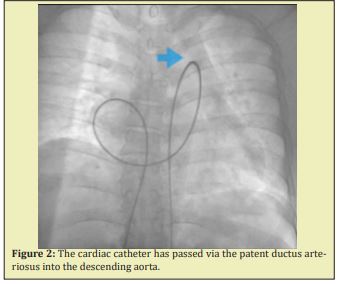A 48 years old patient, with no medical history was referred to the cardiovascular surgeon of our department for a right medio-ventricular resection diagnosed after 2 episodes of syncope. The transthoracic echocardiography revealed a severe RV hypertrophy with aspect of sub-pulmonary stenosis. An invasive hemodynamic assessment was performed and concluded to a severe Pulmonary arterial hypertension. During the invasive right cardiac exploration, the catheter run easily into an unknown large patent ductus arteriosus (PDA). PDA in adults is an extremely rare clinical phenomenon since it is usually discovered and treated during childhood. However, physicians need to be aware of potential situations, signs and symptoms that might suggest a previously undiagnosed PDA.
Keywords: RV hypertrophy, PAH, CHD, Pulmonary pressures
Although few epidemiological data are available on the relationship between adult congenital heart disease and pulmonary arterial hypertension (PAH), a European survey reported that approximately 5-10% of patients with adult congenital heart disease were found to have PAH.1 In most of these patients, prolonged exposure to pulmonary over circulation due to a left-to-right shunt, as well as pressure overload in some cases, can lead to pulmonary arteriopathy that results in a significant increase in pulmonary vascular resistance (PVR). The correct diagnosis of the underlying cause of pulmonary arterial hypertension is essential. Patients with congenital heart disease (CHD)may have an atypical presentation and be referred to expert centers with an incorrect diagnosis. A full investigation is necessary. Careful examination of right ventricular anatomy can provide clues about the etiology of pulmonary hypertension (PH), and it is important to exclude intra- and extracardiac shunts during hemodynamic studies. We report a clinical case of PAH in the context of an overlooked patent ductus arteriosus in adulthood with right ventricular (RV) consequences.
A 48 years old patient, with no medical history was referred to the cardiovascular surgeon of our department for a right medio-ventricular resection diagnosed after 2 episodes of syncope. She had never consulted despite a long period of progressive exertional dyspnea. In the admission, the physical examination identified a blood pressure about 90/50mmHg, a systolic murmur on the left parasternal border and a low peripheral oxygen saturation at 90%. She had no hepatomegaly, ascites nor peripheral edema. The remainder of physical and laboratory examinations were otherwise unremarkable.
The electrocardiogram showed sinus rhythm with right ventricular hypertrophy. The transthoracic echocardiography revealed a severe RV hypertrophy with aspect of sub-pulmonary stenosis, the pulmonary valve was normal with low pulmonary flow (Figure 1). There were no tricuspid or pulmonary regurgitation measurable to evaluate the systolic RV or pulmonary pressures. The dimensions of the left heart and the aortic systolic flow were reduced. Since there were no associated abnormalities that could explain the clinical and ultrasound signs an invasive hemodynamic assessment was performed. Right heart catheterization revealed severe pulmonary arterial hypertension (mean pulmonary artery pressure 101mmHg) with high right atrial pressure (mean right atrial pressure 15mmHg), a very low cardiac index (2L/min/m2) and the total pulmonary resistances were higher than 8UW. There was no response to nitric oxide. During the invasive right cardiac exploration, the catheter run easily into an unknown large patent ductus arteriosus (Figure 2).


Unfortunatly, the patient died in the context of syncope at rest one week later before the specific drugs was given.
This case highlights the potential for misdiagnosis of the underlying cause of PH in adult patients, especially among those with CHD. Always progressive and frequently fatal, PH has a range of etiologies.2 Diagnosis and classification of the underlying cause is vital, as different treatment options are available for different etiologies and stages of PH.
Dyspnea is the most common presenting symptom of PAH, regardless of etiology, but there is a wide range of possible manifestations which can complicate diagnosis.3 In this case, the atypical clinical presentation of patent ductus arteriosus was complicated by the absence of detailed records from a young age, the late onset of symptoms and the physical exam who missed to check the oxygen saturation in both arms and legs.
Careful examination of right ventricular anatomy can provide clues about PAH etiology. In this case, there was significant hypertrophy of the right ventricle. There is a debate about the benefit of right ventricular hypertrophy (RVH) in PAH.4 Increased RV mass can compensate in part for increased PVR and helps maintain cardiac output in PAH. However, there is heterogeneity in the type of RVH seen in PAH and the severity of the hypertrophic response may be considered as being adaptive or maladaptive. Some patients with PAH remain well-compensated while others with identical hemodynamic stress rapidly develop RV failure.5 The adaptive right ventricle accumulates molecular and metabolic abnormalities until a point where it cannot overcome the persistent pressure overload and therefore becomes maladaptive. The transition from adaptive to maladaptive phenotype remains poorly understood and clinically unpredictable.
PAH is an aggressive disease. Early diagnosis and treatment is important particularly in forms for which treatment is available. Misdiagnosis of patients with PAH can lead to substantial morbidity and may be potentially life-threatening.
None.
None.
Author declares that there is no conflict of interest.
- 1. Engelfriet PM, Duffels MG, Moller T, et al. Pulmonary arterial hypertension in adults born with a heart septal defect: the Euro Heart Survey on adult congenital heart disease. Heart. 2007;93:682–687.
- 2. Simonneau G, Galie` N, Rubin LJ, et al. Clinical classification of pulmonary hypertension. J Am Coll Cardiol. 2004;43(12):5S–12S.
- 3. Vizza CD, Badagliacca R, Poscia R, et al. Unusual presentation for a patent ductus arteriosus. Eur Respir Rev. 2009;18:174–176.
- 4. Ryan JJ, Huston J, Kutty S, et al. Right ventricular adaptation and failure in pulmonary arterial hypertension. Can J Cardiol. 2015;31(4):391–406.
- 5. Rich S, Pogoriler J, Husain AN, et al. Long-term effects of epoprostenol on the pulmonary vasculature in idiopathic pulmonary arterial hypertension. Chest. 2010;138(5):1234–1239.

